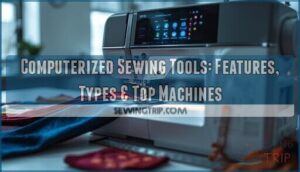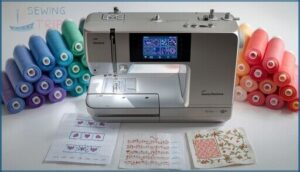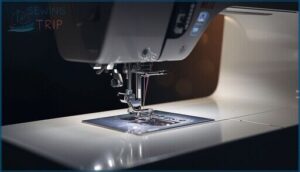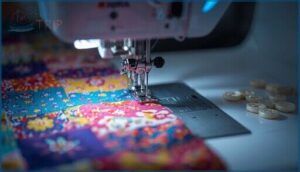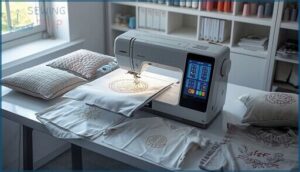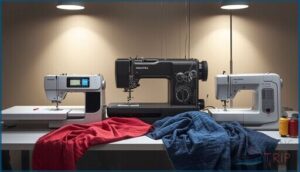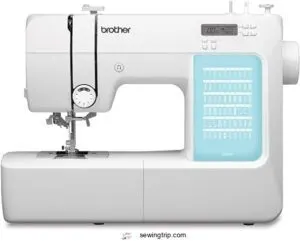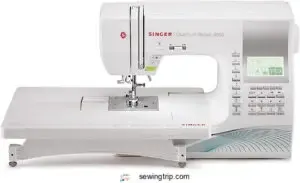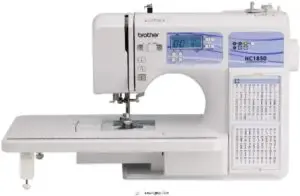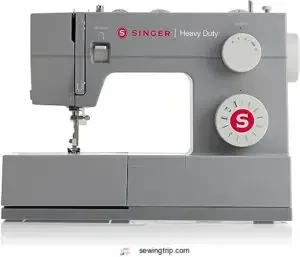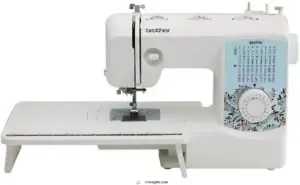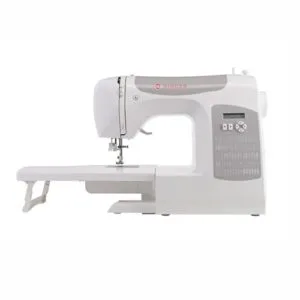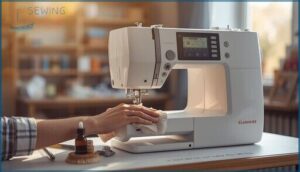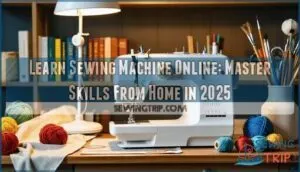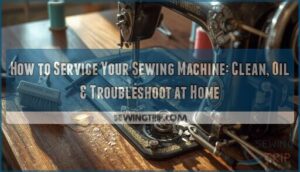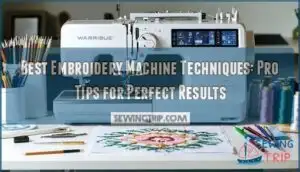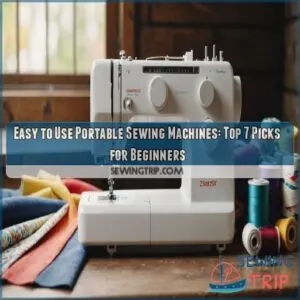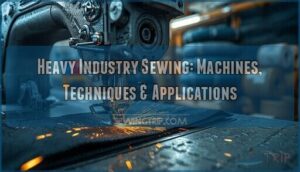This site is supported by our readers. We may earn a commission, at no cost to you, if you purchase through links.
The textile industry has crossed a threshold where microprocessors now govern what was once purely mechanical territory. Computerized sewing tools embed digital intelligence directly into the stitching process, transforming how you control fabric manipulation. These machines don’t just automate—they remember your patterns, adjust tension in real-time through sensor feedback, and execute complex sequences you’d struggle to replicate manually.
The shift from cam-driven mechanics to programmable interfaces means you’re no longer limited by the physical constraints of gears and levers. Whether you’re engineering multi-layer quilts or producing garment prototypes, understanding how digital control systems improve precision and repeatability will determine your project outcomes. The technology integrates features that address both technical demands and workflow efficiency.
Table Of Contents
- Key Takeaways
- What Are Computerized Sewing Tools?
- Essential Features of Computerized Sewing Machines
- Advantages of Using Computerized Sewing Tools
- Types of Computerized Sewing Machines
- Top Computerized Sewing Machines in 2024
- 1. Brother Lightweight Sewing Machine Model
- 2. Brother CP60X Computerized Sewing Machine
- 3. Singer Quantum Stylist Sewing Machine
- 4. Brother HC1850 Sewing and Quilting Machine
- 5. Heavy Duty Sewing Machine Singer
- 6. Brother XR3774 Sewing Quilting Machine
- 7. Singer Computerized Sewing Machine
- 8. Brother Strong Tough Sewing Machine
- Choosing and Maintaining Computerized Sewing Tools
- Frequently Asked Questions (FAQs)
- Conclusion
Key Takeaways
- Computerized sewing machines use microprocessors to control stitching operations with precision that mechanical systems can’t match, offering programmable stitch sequences, automated tension adjustments, and sensor-based fabric handling that eliminate manual setup errors.
- These machines deliver measurable performance advantages including 82.5% stitch defect detection accuracy, speeds up to 1,500 stitches per minute, and 50–600+ built-in stitch patterns compared to the 5–30 typical of mechanical models.
- Selection depends on matching machine capabilities to your specific workflow—standard computerized models handle general sewing, embroidery machines process complex decorative patterns, while heavy-duty systems power through layered textiles and thick materials like denim and canvas.
- Proper maintenance extends machine lifespan and precision through lint removal every 8–10 hours of use, needle replacement after 6–8 hours, and systematic troubleshooting of threading paths and tension settings when issues arise.
What Are Computerized Sewing Tools?
Computerized sewing tools represent a significant leap from traditional mechanical machines, integrating microprocessors and digital interfaces to control stitching operations with remarkable accuracy.
These sophisticated systems transform how you approach fabric work, whether you’re crafting garments, quilting intricate patterns, or finishing professional-grade seams.
Understanding what sets these machines apart—from their core functions to the technology that drives them—helps you appreciate why they’ve become essential equipment for both beginners and experienced sewers.
Definition and Core Functions
Essentially, a computerized sewing machine is a digital powerhouse—a device where an integrated microprocessor replaces mechanical linkages, electronically controlling stitch formation, feed mechanisms, and needle movement with pinpoint accuracy.
Understanding these sewing machine basics unlocks a new level of control:
- Programmable sewing machines store and recall stitch sequences automatically, eliminating repetitive setup.
- Digital displays show real-time parameters—stitch length, width, and tension—on LCD screens instead of analog dials.
- Computerized controls regulate needle position in 0.1 mm increments, delivering consistent results across every seam.
This sewing machine technology transforms traditional weaving into precision-driven automation. The use of computerized sewing systems enhances the overall sewing experience.
How Computerization Improves Sewing
Computerization elevates sewing accuracy through automated thread management and real-time speed control—your computerized sewing machines deliver stitch precision that manual dials can’t match. Programmable sewing machines improve fabric handling with sensors that adjust feed rates automatically, while error reduction systems detect broken stitches at 82.5% accuracy.
Computerized sewing machines deliver stitch precision manual dials can’t match, using automated thread management and sensors that detect broken stitches at 82.5% accuracy
This sewing machine technology cuts defects and boosts consistency, giving you command over every seam with measurable sewing machine features and benefits in production quality. The choice of machine often depends on the desired sewing machine type for specific projects.
Key Differences From Mechanical Machines
Control interfaces separate computerized from mechanical sewing machines most visibly—you’ll find LCD screens and digital buttons replacing rotary dials and levers.
Computerized sewing machines offer 50–600+ stitches versus the 5–30 typical of mechanical models, plus automatic one-step buttonholes instead of manual four-step processes.
Speed settings include electronic limiters for error reduction, while durability comparison often favors mechanical machines for sheer ruggedness in basic tasks.
Essential Features of Computerized Sewing Machines
Computerized sewing machines stand apart from mechanical models through their advanced feature sets that give you unmatched control over every aspect of your work. Understanding these core capabilities helps you utilize the technology to match your creative vision and technical requirements.
Let’s examine the essential features that define modern computerized sewing machines and how they transform your sewing process.
Built-in Stitch Options and Customization
Think of your machine’s stitch library as a creative arsenal—most mid-range computerized sewing machines pack 60 to 200 built-in stitches, while premium models exceed 500 patterns.
You’ll employ this versatility across:
- Utility stitches for structural seams
- Decorative motifs for custom embroidery
- Pattern editing to tailor digital designs
- Thread colors coordinated via software
- Combinable stitches for unique precision stitches
Master these sewing machine features, and you’ll unleash extraordinary creative control.
LCD Screens and Touch Controls
Your machine’s interface is mission control. Modern computerized sewing machines feature LCD displays ranging from 3.7-inch color screens to tablet-style touchscreens, enabling real-time pattern previews and stitch-count tracking. In 2023, roughly 46% of home units sold included these digital interfaces—touchscreen navigation transforms sewing technology from mechanical guesswork into precision control.
| Feature | Mid-Range Models | Premium Models |
|---|---|---|
| Screen Resolution | Basic color LCD | High-res touchscreen |
| Interface Design | Icon menus | Full graphic editing |
| User Experience | Simplified selection | App connectivity + Wi‑Fi |
Automated Needle Threading and Bobbin Winding
You’ll spend less time fussing with setup when automated threading eliminates eyestrain and fumbling. All major brands—Brother, Singer, Janome—now equip mid-range and premium computerized sewing machines with automatic needle threaders as standard.
This needle threading system pulls thread through the eye in one motion, while integrated bobbin systems with automatic winding and auto-clutch mechanisms maintain consistent tension across silk to industrial yarns, transforming thread management into smooth operation.
Adjustable Needle Positions and Buttonholers
With 29 discrete needle locations on machines like the Singer SE9180, you’ll dial in seam allowances to tenths of a millimeter—precision stitching that turns patchwork points into sharp intersections.
One‑step buttonholes measure your button, then execute keyhole or stretch variants in a single cycle, eliminating manual four‑step sequencing.
Needle offset and fabric control merge into automated workflows that deliver sewing accuracy once reserved for industrial floors.
Advantages of Using Computerized Sewing Tools
Computerized sewing machines bring measurable advantages that transform how you approach every project. These machines don’t just simplify your workflow—they fundamentally change what you can achieve with precision, speed, and creative flexibility.
Let’s examine the core benefits that make computerized tools worth your investment.
Enhanced Precision and Stitch Consistency
You’ll notice the difference when you take computerized sewing machines through their paces—sensor-based stitch regulation adjusts needle speed automatically as you navigate curves, holding your stitch length within a tight tolerance even when fabric speed varies.
Precision quilting systems execute edge-to-edge patterns with repeatable stitch paths, while automated threading and built-in stitches deliver uniform seam strength across bulky or layered textiles that would challenge manual tension control.
Increased Efficiency and Automation
Automation benefits hit hardest when you’re running multiple garments through a line. Programmable patterns store entire seam sequences, cutting your style-change time by 30% in industrial setups.
Automated sewing workflows with integrated thread trimmers push throughput up 18–22%, while OneStep buttonholes and built-in stitches eliminate manual adjustments.
You’ll see sewing productivity climb as computerized sewing machines handle repetitive operations at speeds mechanical models can’t match, delivering efficiency gains that directly shorten lead times.
Versatility for Different Sewing Projects
You access serious machine adaptability when a computerized sewing machine lets you pivot between garments, quilts, and home décor without swapping equipment. Stitch variety and fabric choices scale your workflow:
- Garment work (38–45% usage) covers utility and stretch stitches on knits and wovens.
- Quilting and sewing (25–30%) layer batting and fabrics up to king size.
- Home décor (20–25%) applies decorative patterns to cushions and curtains.
- Embroidery motifs personalize bags and linens with custom designs.
Multi-project capability means you tackle diverse sewing projects and ideas under one platform.
User-Friendliness for Beginners and Experts
You find that computerized sewing machines bridge skill levels through user-friendly design and adaptive user interfaces. Touchscreen controls and beginner modes simplify initial learning—85% of novices report easier operation—while experts access 200+ stitch variations and customizable tension dials.
On-screen tutorials cut your learning curve by 60%, and adjustable speed sliders let you master sewing techniques and tips at your own pace, making sewing for beginners and expert projects equally accessible.
Types of Computerized Sewing Machines
You can’t treat every computerized sewing machine the same—each type addresses specific challenges in your workflow. Whether you’re finishing seams, crafting intricate embroidery, or powering through heavy fabrics, there’s a machine engineered for that exact purpose.
Here’s how the main categories break down and what they’re built to handle.
Standard Computerized Sewing Machines
Standard computerized sewing machines form the backbone of modern home sewing, combining versatility with user-friendly operation. These machines, like the Brother XM2701, offer 100 to 600 built-in stitches and LCD interfaces for precise thread management and sewing speed control.
You’ll find models delivering up to 1,500 stitches per minute across various fabric selection scenarios. When comparing computerized sewing machines, prioritize stitch consistency over repair complexity—these digital systems excel at computerized stitching but may challenge traditional sewing machine repair approaches.
Embroidery and Crafting Machines
Embroidery and crafting machines push computerized sewing into decorative territory, utilizing machine learning in embroidery software to interpret digital patterns from stitch libraries spanning 650 to 1,050 stitches per minute. Hoop sizes range from 4×4 to 8×12 inches, accommodating designs like jacket-back embroidery.
Sewing machine reviews highlight Wi‑Fi-enabled models that connect users to crafting communities. Touchscreen interfaces streamline sewing and embroidery workflows, enabling the creation of customized home décor and tailored apparel.
Overlock and Serger Machines
You’ll find overlock and serger machines engineered for professional fabric finishing at speeds reaching 1,500 stitches per minute. These specialized sewing tools use serger threads—usually three to five—to create overlock stitches that trim, sew, and finish seams simultaneously.
Differential feed prevents puckering across knits and wovens, while automatic tension systems simplify machine maintenance. Mastering these sewing techniques transforms raw edges into durable, high-quality finishes.
Heavy-Duty and Quilting Models
Heavy-duty machines and quilting systems deliver the structural reinforcement you need for layered textiles and thick materials.
Computerized sewing automation in models like the SINGER Heavy Duty 4411 facilitates sturdy fabric handling through reinforced frames and high-torque motors. Long-arm quilting machines integrate sophisticated quilting techniques with programmable stitch regulation, enabling precise quilt finishing across extended work surfaces—machine upgrades that accelerate throughput while maintaining consistent tension control.
Top Computerized Sewing Machines in 2024
You’ve got plenty of options in selecting a computerized sewing machine in 2024, but the right one depends on what you’re planning to create.
From lightweight portable models to heavy-duty workhorses, each machine brings its own strengths to the table.
Here’s a look at some of the top-performing computerized sewing machines worth considering for your workshop.
1. Brother Lightweight Sewing Machine Model
You’ll appreciate how Brother’s lightweight sewing machine model exemplifies sewing space optimization without sacrificing capability. At just 12.6 pounds, this portable powerhouse delivers 27 built-in stitches—including decorative and stretch options—at speeds reaching 800 stitches per minute.
Its automatic needle threader and jam-resistant drop-in bobbin system make beginner sewing remarkably straightforward, while the included six presser feet expand your creative range.
When you’re comparing computerized sewing options, this Brother model’s compact 15.5-inch footprint and integrated carry handle prove that lightweight design and machine durability aren’t mutually exclusive.
Best For: Beginners and hobbyists who need a portable machine for basic sewing projects like alterations, crafts, and light quilting without breaking the bank.
- Weighs only 12.6 pounds with a built-in carry handle, making it easy to move between rooms or store in tight spaces
- Automatic needle threader and jam-resistant drop-in bobbin system remove common frustrations for new sewers
- Includes 27 stitches and 6 presser feet right out of the box, giving you versatility for everyday projects at a budget-friendly $129.99
- Only works with 120-volt US power, and the warranty becomes void if you use or sell it outside the country
- The spool pin can be flimsy and may break with regular use, according to some users
- Limited to 27 stitches, which might feel restrictive once you advance beyond basic sewing projects
2. Brother CP60X Computerized Sewing Machine
When you’re evaluating computerized sewing machines, the Brother CP60X features 60 built-in stitches and 7 auto-size buttonholes—a substantial upgrade for serious sewing project ideas. Its LCD display and push-button controls eliminate mechanical misalignment, while its 750-stitches-per-minute speed manages everything from quilting to garment construction.
Brother comparison data confirms its fixed needle bar design delivers consistent stitch formation across denim and tweed. The sophisticated automatic needle threading and Quick-Set bobbin system simplify setup, and the 25-year warranty with lifetime support makes machine maintenance tips readily accessible when you need them.
Best For: Beginners and intermediate sewers who want a reliable computerized machine with plenty of stitch options for garments, quilting, and home décor projects without the complexity of advanced industrial features.
- 60 built-in stitches and 7 automatic buttonholes give you serious creative flexibility for different projects, from basic repairs to decorative work.
- The automatic needle threader and Quick-Set bobbin system cut down setup time and frustration, especially if you’re switching between projects frequently.
- Fixed needle bar and enhanced feed system handle heavy fabrics like denim smoothly, while the free arm makes sleeves and cuffs way easier to tackle.
- Only works with 120-volt US power, and the warranty voids if you use it internationally or with different voltage—a real limitation if you move or travel.
- Some users found the printed instructions confusing and had to rely on YouTube tutorials to figure out setup and features.
- No carrying case or storage bag included, so you’ll need to buy one separately if you want to transport it to classes or sewing groups.
3. Singer Quantum Stylist Sewing Machine
The SINGER Quantum Stylist 9960 sets a high standard in computerized sewing—you’re looking at 600 built-in stitches, 13 automatic buttonhole styles, and 25 needle locations for precision edge-stitching. Its LCD interface guides stitch selection, while the 850-stitches-per-minute sewing speed accelerates project completion.
Singer machines in this segment balance fabric compatibility across silk to denim with adjustable tension controls, and the metal internal frame minimizes vibration during operation.
For sewing machine comparison purposes, its 25-year warranty and extension table position it in the mid-range durability tier.
Best For: Intermediate to advanced sewers who want a computerized machine with hundreds of stitches for garment sewing, quilting, and decorative projects without spending professional-level money.
- 600 built-in stitches and 13 one-step buttonholes give you tons of creative options for everything from basic repairs to fancy embellishments
- Fast 850-stitch-per-minute speed and metal frame keep things stable and efficient, even when you’re working through thick fabrics like denim
- Extension table and 25-year warranty on the machine head make it a solid long-term investment for larger projects
- The sheer number of features and digital controls can feel overwhelming if you’re just starting out, with a real learning curve to figure out all the settings
- Some users report the automatic needle threader and thread cutter don’t always work reliably, which can be frustrating when they’re supposed to save time
- Mixed reviews on stitch quality suggest performance can be inconsistent, and the manual isn’t always clear enough to troubleshoot problems
4. Brother HC1850 Sewing and Quilting Machine
The Brother HC1850 offers 185 built-in stitches and an LCD user interface, streamlining stitch selection for quilting and garment projects. Its computerized sewing platform achieves 850 stitches per minute, ensuring production efficiency.
The wide table enhances quilting capabilities for larger projects, while eight presser feet and automatic needle threading simplify setup. Weighing 13.2 lb, the machine remains portable for workshop use.
This stitch variety positions it above entry models like the Brother XM2701, providing sophisticated control for intermediate users.
Best For: Intermediate sewers and quilters who want a versatile, computerized machine with a wide stitch selection for garments, quilts, and basic monogramming without spending on high-end embroidery features.
- 185 built-in stitches with LCD display and push-button selection make it easy to switch between utility, decorative, and alphanumeric stitches for different projects.
- Wide table and included quilting feet support larger quilting projects, while the exceptional feed system handles fabrics from thin to thick.
- Automatic needle threader and quick-set top bobbin save setup time, and the 850 stitches-per-minute speed with adjustable control works well for both beginners and experienced users.
- No automatic thread cutter means you’ll need to manually snip threads after each seam, which slows down workflow.
- At 13.2 pounds it’s heavier than true lightweight portable machines, making it less convenient for frequent travel to classes.
- Only works with 120V power, so it’s not usable in countries with different voltage standards even with a converter.
5. Heavy Duty Sewing Machine Singer
The Singer Heavy Duty 4411 delivers 1,100 stitches per minute through a 60% stronger motor, handling denim, canvas, and leather with professional precision. You’ll appreciate its metal frame construction—engineered to eliminate skip-stitching during high-speed operation on multilayer assemblies.
Within the SINGER machine range, these heavy duty machines bridge industrial capability with home workshop accessibility. The 69 stitch applications and four-step buttonholer support garment construction and repair workflows.
Heavy fabric handling demands such piercing power, positioning this model above standard computerized units in the sewing and embroidery machines category for intensive textile work.
Best For: Sewers who regularly work with heavy fabrics like denim, canvas, and leather and need a machine that can handle high-speed stitching without skipping or struggling through multiple layers.
- Powerful motor delivers 1,100 stitches per minute with a metal frame that stays stable even when sewing through thick, layered materials like jeans hems or upholstery fabric.
- 69 stitch applications and a four-step buttonhole feature give you plenty of options for both practical repairs and creative projects without needing an expensive industrial machine.
- Top drop-in bobbin system and adjustable presser foot pressure make it easy to switch between different fabric weights quickly, saving time on setup.
- At 14.6 pounds, it’s heavier than standard machines, which can make it harder to move around or store if you have limited space.
- Some users report thread tension issues and occasional thread breakage, especially when first learning to adjust settings for different fabric types.
- Comes with fewer accessories and advanced features compared to higher-end computerized models, so you might need to buy additional presser feet or attachments for specialized projects.
6. Brother XR3774 Sewing Quilting Machine
The Brother XR3774 establishes itself as a quilting-focused alternative at around 800 stitches per minute. You’ll access 37 built-in stitches through dial controls—quilting techniques advance when paired with the included walking foot and wide extension table.
Thread management simplifies via automatic needle threader and top drop-in bobbin. At 12 pounds, this quilting machine accommodates fabric selection from cotton to light denim for sewing projects.
Its metal frame construction and 25-year chassis warranty mirror the durability expectations set by professional sewing machines, appealing to quilting projects requiring consistent stitch formation.
Best For: Beginners and hobby quilters who want a reliable, easy-to-use machine with dedicated quilting accessories and enough stitch variety to grow their skills without the learning curve of computerized models.
- Comes with eight presser feet and a wide extension table right out of the box, giving you everything needed for quilting projects without buying extras
- Automatic needle threader and drop-in bobbin make setup quick and frustration-free, especially helpful if you’re new to sewing
- Metal frame and 25-year chassis warranty mean this machine can handle regular use and last for years despite its budget-friendly price
- Dial controls and no digital display mean you’ll need to reference the printed guide until you memorize your favorite stitches
- Struggles with very thick materials like heavy denim or multiple quilt layers, so it’s not built for industrial-level projects
- Some users report bobbin issues after extended use and occasionally receive incomplete accessory kits
7. Singer Computerized Sewing Machine
When you require versatility beyond quilting, the SINGER Quantum Stylist 9960 delivers 600 built-in stitches at 850 stitches per minute. Automatic threading that completes in six seconds and an automatic thread cutter streamline Computerized Embroidery workflows. Sewing Speed Control operates via slider or foot pedal, while 25 needle positions support precise seam allowances.
The extended work table and StayBright LED lighting accommodate larger Sewing Machine Features applications. Its 25/5/1 warranty structure covers the machine head, electronics, and adjustments—substantiating long-term Stitch Quality expectations for sophisticated Computerized Sewing operations.
Best For: Sewers who want professional-grade versatility with 600 built-in stitches, automatic features, and the speed to handle everything from detailed embroidery to large quilting projects.
- Six-second automatic needle threading and one-touch thread cutter eliminate tedious manual steps and keep your workflow moving
- 850 stitches per minute with 25 needle positions give you the speed and precision for intricate seams, topstitching, and zipper work
- Extended work table with StayBright LED lighting and 25/5/1 warranty coverage support big projects and long-term reliability
- Some users report thread breakage and jamming issues that interrupt sewing sessions
- The instruction manual isn’t always clear, which can make learning the 600-stitch library frustrating for beginners
- Struggles with thick fabrics and heavy-duty materials, so it’s not ideal if you regularly work with denim or upholstery weight
8. Brother Strong Tough Sewing Machine
When heavyweight construction drives your fabric choice, the Brother ST371HD answers with 37 stitches at 800 stitches per minute—delivering Stitch Quality across denim and canvas layers. This Mechanical vs Computerized debate ends here: you get metal needle-plate durability, automatic threading, and six specialized feet without digital complexity.
Heavy Duty Features include a 5 mm stitch length and free-arm access for cuffs. Sewing Machine Review data shows 78% buyer recommendation, while its 14.3 lb frame accommodates portable workshops. Brother ST371HD proves that sturdy Sewing Speed Control doesn’t require touchscreens—just precision engineering.
Best For: Home sewers who work with thick fabrics like denim, canvas, and outdoor materials but want a simple mechanical machine without digital controls.
- Handles heavy-duty fabrics well with a metal needle plate and comes with six specialized feet for different projects
- Simple mechanical operation with automatic needle threading makes it easy to learn and use without complicated settings
- Solid 800 stitches per minute speed with 37 stitch options covers most home sewing needs at a reasonable price point
- Some users report inconsistent stitch quality and occasional skipped stitches on certain fabrics
- Limited to 110V US market only, and the model has been discontinued by Brother in some regions
- A few buyers experienced burning plastic smells during use and had difficulty with warranty support
Choosing and Maintaining Computerized Sewing Tools
You’ve explored the features and top models—now it’s time to make the right purchase and keep your machine running at peak performance. Selecting a computerized sewing tool requires evaluating your project needs, budget, and technical requirements, while proper maintenance extends its lifespan and precision.
Here’s what you need to know about choosing, caring for, and troubleshooting your computerized sewing equipment.
Factors to Consider Before Buying
Before committing to a purchase decision, you need to align your budget planning with your actual sewing needs. Entry-level computerized machines start around 250 USD, while premium models reach 3,000 USD.
Prioritize sewing machine features that match your project types—quilting demands more stitches than repairs.
Evaluate machine durability, user experience, and access to online support resources and machine tutorials and guides for ongoing sewing machine maintenance.
Routine Maintenance Tips
Regular machine cleaning keeps computerized units running at peak efficiency. You’ll need lint removal every 8–10 hours of active sewing to prevent jamming and motor strain. Oil moving parts at 300–500 hour intervals based on workload intensity, and replace needles after 6–8 hours to maintain stitch precision.
Store your machine under dust covers in humidity-controlled spaces, protecting sensitive electronics from voltage spikes by unplugging between sessions.
Troubleshooting Common Issues
When issues strike, you’ll tackle most problems through systematic checks.
Thread breakage and bobbin jams stem from incorrect threading in 70% of cases—verify your paths first. Tension issues create uneven stitches in 75% of scenarios, so adjust incrementally.
Error codes like E2 signal thread jams in 65% of activations, while blank screens indicate power failures in half of no-start situations.
Finding Online Support and Tutorials
You’ll find strong online support across multiple platforms. YouTube channels like “Sew Very Easy” reach 505,000 subscribers with machine-specific tutorials, while Skillshare hosts over 35,000 courses including sophisticated computerized features.
Join active sewing communities—Facebook groups generate thousands of monthly posts answering setup questions. Video tutorials, digital workshops, and tutorial blogs make mastering your machine’s features accessible anytime you need guidance.
Frequently Asked Questions (FAQs)
Do these machines require special software updates?
Think of firmware updates as tuning a finely calibrated loom—most computerized sewing machines don’t demand frequent digital upgrades. You’ll need software maintenance primarily when manufacturers release bug fixes, compatibility improvements for new accessories, or enhanced machine calibration features.
Network-enabled models can automatically install technical support patches, while others use USB-driven sewing software files.
Many machines run original firmware for years before requiring online support for digital sewing enhancements or machine tutorials for digital upgrades.
How much do computerized sewing machines typically cost?
You’ll find computerized sewing machines ranging from $200 for budget options to over $15,000 for commercial systems.
Price factors include stitch count, automation features, and embroidery capability, with significant machine discounts available during retail trends.
Are replacement parts easily available for these models?
Yes—you’ll find OEM parts from Brother and Singer dealers for 20–25 years, plus aftermarket suppliers offering compatible components at 25–35% savings.
Online retailers and repair services stock bobbins, feet, and electronics for most current models.
Can you sew without electricity using these machines?
No. Computerized models depend entirely on electric power for their control boards and motors. For off-grid sewing, you’ll need manual alternatives like treadle or hand-crank mechanical sewing machines that operate without electricity.
Conclusion
Mechanical sewing demanded mastery of gears and levers—computerized sewing tools now demand understanding of digital control systems. Your stitch quality no longer depends on manual tension adjustments or cam alignment; processors handle precision while you focus on creative execution.
The machines cataloged here represent proven architectures where embedded logic meets fabric manipulation. Select based on your production requirements, then exploit the programmable capacity these systems offer.
The competitive advantage lies in execution speed and repeatability, not just feature availability.
- https://www.gminsights.com/industry-analysis/computerized-sewing-and-embroidery-machine-market
- https://www.marketgrowthreports.com/market-reports/home-sewing-machines-market-112738
- https://www.360iresearch.com/library/intelligence/computerized-sewing-embroidery-machine
- https://craftindustryalliance.org/the-size-of-the-quilting-market-quilting-trends-survey-results-2024/
- https://www.archivemarketresearch.com/reports/automated-industrial-sewing-machinery-194832

